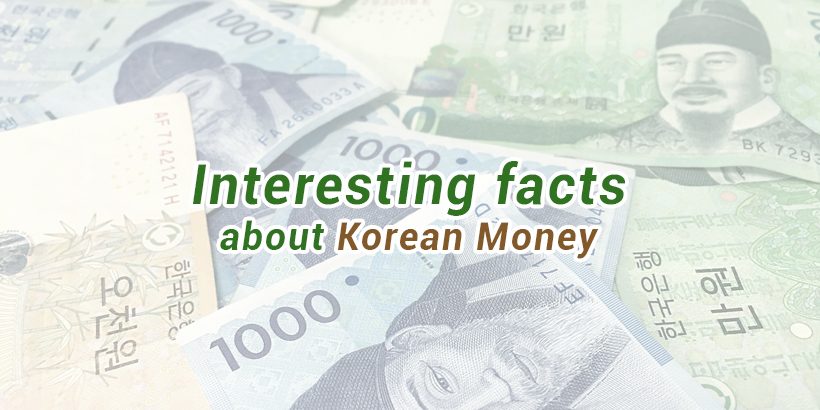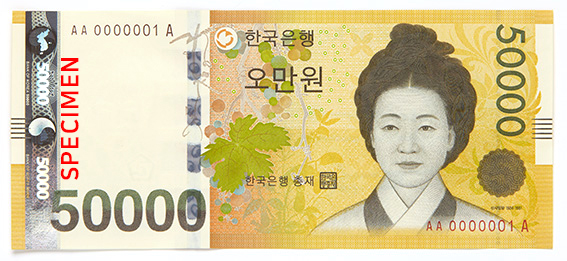
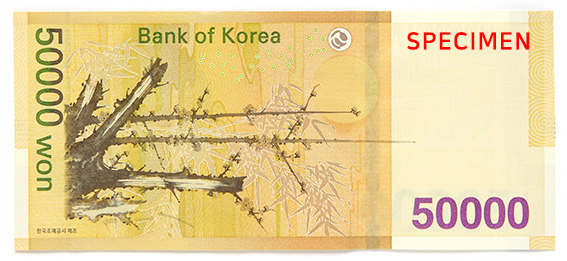
Fifty thousand won
/ 50,000 won
[o-man-won]
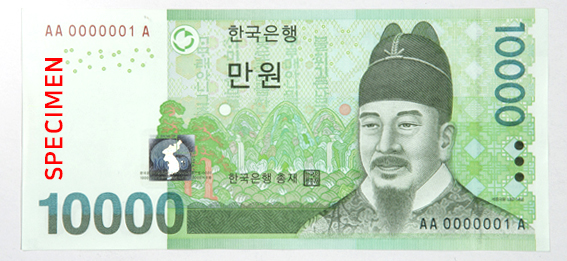
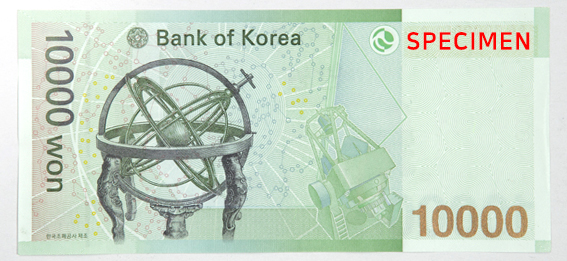
Ten thousand won
/ 10,000 won
[man-won]
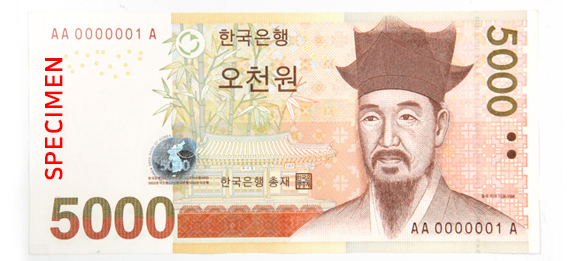
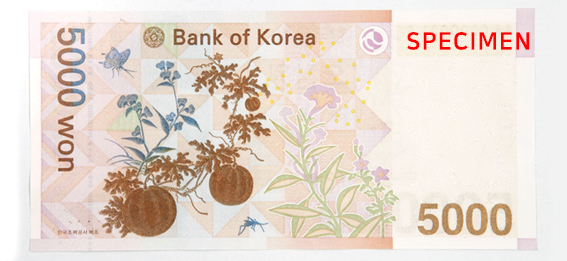
Five thousand won
/ 5,000 won
[o-cheon-won]
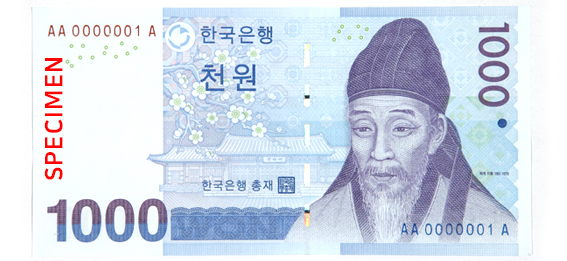
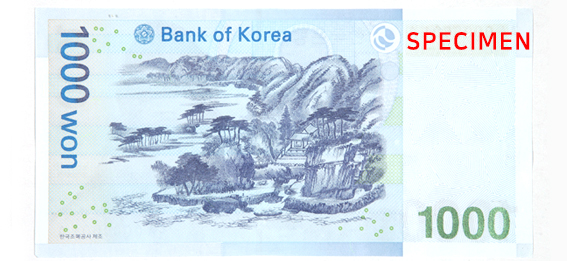
One thousand won
/ 1,000 won
[cheon-won]
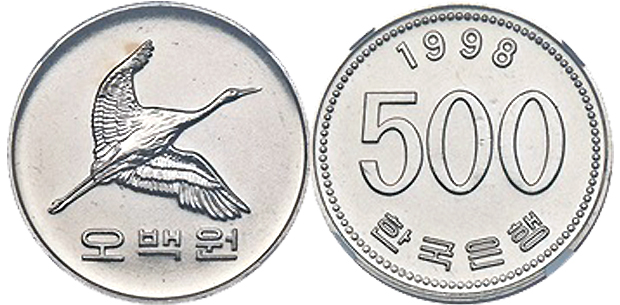
Five hundred won
/ 500 won
[o-baek-won]
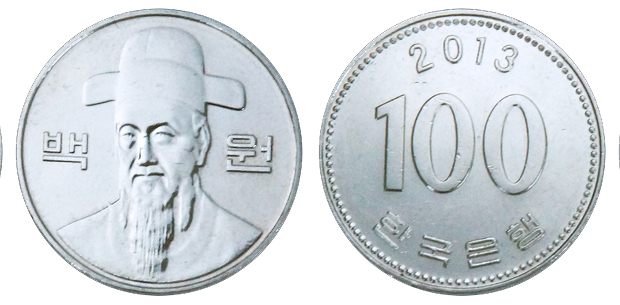
One hundred won
/ 100 won
[baek-won]
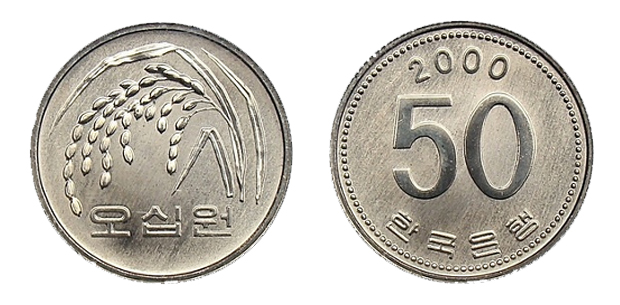
Fifty won
/ 50 won
[o-sip-won]
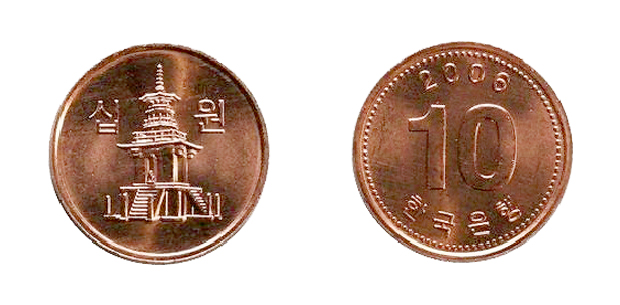
Ten won
/ 10 won
[sip-won]
Fifty thousand won / 50,000 won


Shin Saimdang (1504-1551)
Shin Saimdang was a Korean artist, writer, calligraphist, and poet. She is the first woman to appear on a South Korean Banknote. She was also the mother of the Korean Confucian scholar Yi I. (You can find him in 1,000 won bill) Although Shin Saimdang showed wide range of talents, her image is fixed as a good wife and a wise mother.
‘Wolmaedo’ and ‘Pungjugdo’
Interestingly, the illustration on the back side of the bill is illustrated vertically whereas most of the pictures are illustrated horizontally. Wolmaedo and Pungjugdo are paintings of the Joseon dynasty.
Ten thousand won / 10,000 won


King Sejong the Great (1397-1450)
Sejong the Great was the fourth king of the Joseon dynasty of Korea. Sejong reinforced Confucian policies and personally created and promulgated the Korean alphabet Hangul, encouraged advancements of scientific technology and instituted many other efforts to stabilize the improve prosperity.
‘Honcheonui’ (Armillary sphere)
An armillary sphere is a model of objects in the sky, consisting of a spherical framework of rings, centred on Earth or the Sun, that represent lines of celestial longitude and latitude and other astronomically important features, such as the ecliptic. In Korea, Jang Yeong-sil, a Korean inventor was ordered by King Sejong the Great to build an armillary sphere. It was built in 1433 and named Honcheonui.
Five thousand won / 5,000 won


Yulgok Yi I (1536-1584)
Yi I was one of the two most prominent Korean Confucian scholars of the Joseon Dynasty. Yi I is often referred to by his pen name Yulgok (Chestnut valley). His mother, Shin Saimdang is the person who is depicted on the Korean 50,000 note. It is said that by the age of seven he had finished his lessons in the Confucian classics and passed the Civil Service literary examination at the age of 13. He continuously received top honors on civil exams for a consecutive 9 years, and served in various positions in government from the age of 29. Due to his vast experience in different offices over the years, he was able to garner a wide vision of politics and with the deep trust of the king, became one of the central figures of politics by the time he was 40.
‘Watermelon and Insect’
Chochungdo is a painting genre initiated by Shin Saimdang, depicting plants and insects. Shin Saimdang is the mother of Yi I, and the paintings of ‘Watermelon and Insect’ and ‘Flower and Frog’ are known to be drawn by her.
One thousand won / 1,000 won


Toegye Yi Hwang (1501-1570)
Yi Hwang is one of the two most prominent Korean Confucian scholars of the Joseon Dynasty. The other is his younger contemporary Yi I, the one depicted in the Korean 5,000 note. Yi Hwang is often referred to by his pen name Toegye (Retreating Creek). He estabilished the Yeongnam School and set up the Dosan Seowon, a private Confucian academy. Yi Hwang was disillusioned by the power struggle and discord in the royal court during the later years of King Jungjong’s reign and left political office. However, he was continuously brought out of retirement and held several positions away from the royal court and in rural areas. During forty years of public life he served four kings. On his death, Yi Hwang was posthumously promoted to the highest ministerial rank.
‘Dosan Seowon’
Dosan Seowon was established in 1574 in what is present day Andong, South Korea, in memory of and four years after the death of Korean Confucian scholar Yi Hwang by some of his disciples and other Korean Confucian authorities.
Five hundred won / 500 won

Crane
Cranes are a family of large, long-legged and long-necked birds in the group Gruiformes. Cranes represents peace and longevity and was depicted on the obverse on the KRW 500 coin in hope for prosperous development of the country.
One hundred won / 100 won

Admiral Yi Sun-sin
Admiral Yi Sun-sin (1545-1598) was a Korean naval commander famed for his victories against the Japanese navy during the Imjin war in the Josen Dynasty. Despite the fact that he had no prior naval tranining, admiral Yi was never defeated at sea nor lost a single shop under his command to enemy action, and militay historians have placed him as one of the greatest naval commanders in history.
Fifty won / 50 won

An ear of rice
There are many stories on how it got depicted on the obverse of the KRW 50 coin. There are sayings that it represents ‘Eat well, Live well’ after the Korean War and other suggestions such as it is to show the beauty of National animals and plants. The fact is, Food and Agriculture Organization of the United Nations (FAO) recommended to design a coin to celebrate World Food Day (October 16th) and thus engraved rice, which is the staple food in Korea.
Ten won / 10 won

Dabo Pagoda
Dabo Pagoda is located in the temple of Bulgukssa in Gyeongju, South Korea. The pagoda is supposed to have been built in 751, the 10th year of the Shilla king Gyeongdeok. It is currently designated as National Treasure no.20. It was built in an ornate style not seen in other Buddhist countries. The sculpture techniques used are unique for its time and include delicate features.

